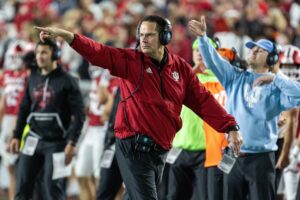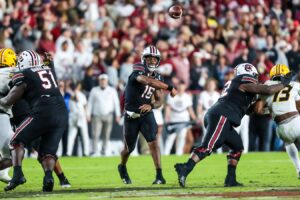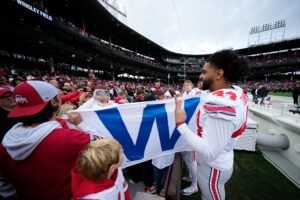For the West Virginia Mountaineer football team, the 2018 season concluded with an exciting, but unsuccessful finale. The Mountaineers lost a heartbreaker 59-56 against the Oklahoma Sooners. As we impatiently wait for bowl selections next weekend, however, it is fair to ask what’s next for the Mountaineers.
Season Recap
The Projections
Before looking ahead, it is worth taking a brief look at the team’s performance. The Mountaineers finished 8-3 on the season, having its 12-game slate shortened by one due to Hurricane Florence. In conference play, the Mountaineers finished 6-3, good for third in the Big XII. Both marks eclipsed the national preseason projections and betting lines. And the Mountaineers remain in the top 15 in the most recent AP poll (and 16th in our own poll). As such, it is difficult to call this season a disappointment.
Behind the Record
Behind the record, however, we find the true tenor of this season. The Mountaineers suffered upset losses against Iowa State and Oklahoma State. After building a 31-10 lead at halftime, the loss to the Cowboys was particularly difficult to swallow. More than any other, that loss prevented the Mountaineers from playing this weekend in the Big XII championship game.
Even more, however, the two upset losses mark the difference between a historic season for this year’s West Virginia team and a solid season that will likely see the Mountaineers finish in the top 25 for the first time since 2016. If the Mountaineers beat Iowa State, they will head into the matchup with Oklahoma State ranked 5th in the country. And, if they beat Oklahoma State, the Mountaineers would have been playing the Sooners for the right to take over the spot Michigan just surrendered in the College Football Playoff.
That is the real reason for Mountaineer Nation disappointment. West Virginia does not have a long-standing history as a top-ten team or national title contender. It is not a traditional power, in other words. But it had assembled a solid collection of talent with a legitimate Heisman contender. This could have been one of those rare years (and there have been exactly three in Mountaineer history) where the Mountaineers remained nationally relevant through the very end. But two upset losses later, and fans are left to wonder “what if?”
The Stats
Statistically, the Mountaineers faithful have a lot to be thankful for. Will Grier finished the regular season fourth in total years (would have been first with one more game), fourth in yards per attempt, second in passing touchdowns, and fifth in passer rating. Two West Virginia receivers finished in the top five in touchdown receptions: David Sills at seconds with 15 and Gary Jennings at fifth with 13. As a unit, the West Virginia offense finished eighth in yards per game and ninth in points per game.
Defensively, the team improved dramatically from last year, even though the month of November was unkind to the team. Through the first eight games, however, defensive coordinator Tony Gibson marched out a top 25 unit despite mounting injuries at linebacker, cornerback, and safety that created a lot of wear on the unit. That wear and tear, coupled with the matchups against Texas, Oklahoma State, and Oklahoma, caused regression over the final weeks.
The Staff
Over the past week, head coach Dana Holgorsen’s name has been attached to openings at Louisville, North Carolina, Colorado, and Texas Tech. A small but vocal contingent of fans has, as always, been calling for Holgorsen’s job. And a couple ill-informed and unimaginative writers have even joined that particular choir. Asking for coaching changes at the top is a drastic measure, and it is not justified here.
The middle ground, of course, is to make changes to the coordinators. Some fans have placed blame on the shoulders of Gibson and offensive coordinator Jake Spavital. The latter is, to be blunt, is absurd. Spavital has been responsible for the development of an impressive list of elite college-level quarterbacks, and his unit finished in the top ten in the nation this season.
Statistically, the former seems more reasonable, but it is equally unwise. Gibson brought a unique defense to the Big XII. Prior to his reintroduction to Morgantown, West Virginia fielded the worst defense in the conference. The 3-3-5 has been successful enough in disrupting the timing of the conference’s offenses that several defensively-minded coaches, including Coach Gary Patterson at TCU, have tinkered with their own base defenses to install some of the concepts Gibson employs regularly.
That is not to say Gibson does not have work to do; he would tell you himself that he does. Gibson might work on employing four-man sets, a concept he experimented with successfully against Tennessee. He might also revisit his own tendencies, particularly when to employ Cover Zero techniques and when to bring and avoid bringing pressure. No matter he does, however, his unit will still face several of the best offenses in the country, and those offenses will score a lot of points. Expecting otherwise (even though Gibson and his players do) is unrealistic.
The Bowl Projection
While the rumor mill will continue to swirl, and fans and writers will debate the merits of the players and staff and everything in between, the Mountaineers look forward to the Early Signing Period in recruiting. We will provide some updates and notes on where West Virginia stands with its 2019 recruiting class shortly. In the meantime, West Virginia also awaits a verdict on its bowl opponent and location.
A few bowls are possible for the Mountaineers. In order, the Sugar Bowl, the Alamo Bowl, the Camping World Bowl, and the Academy Sports + Outdoors Texas Bowl have priority over bowl-eligible Big XII teams. If Oklahoma is selected to participate in the playoff, then Texas will play in the Sugar Bowl. That leaves the Alamo Bowl and the Camping World Bowl to pick between Iowa State and West Virginia. Otherwise, the Camping World Bowl and Texas Bowl would pick between the two (as Texas would fall into the Alamo Bowl).
Under either scenario, the Camping World Bowl in Orlando, Florida is the most likely destination for the Mountaineers. And that game features a few juicy matchups, as the Camping World Bowl will likely have NC State, Pitt, and Syracuse to choose from. Though consensus builds nationally around a matchup between Syracuse and West Virginia, the potential Backyard Brawl bowl matchup could simply be too tempting for the Camping World Bowl to pass up, regardless the final ACC rankings.
Returning to the original question: What’s Next for the West Virginia Mountaineers? The answer could very well be a late-December date in Orlando with the Pitt Panthers.
Main Photo Credit:







